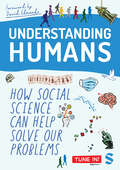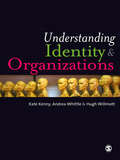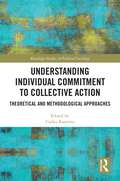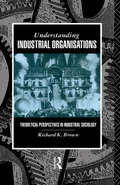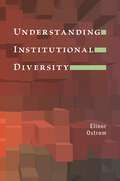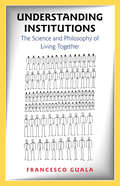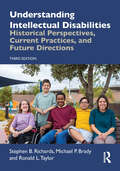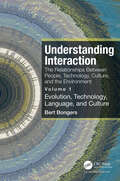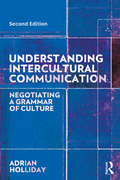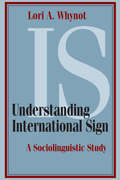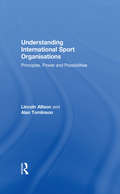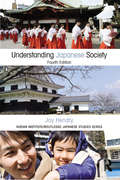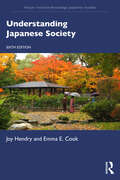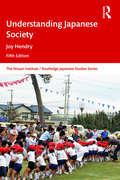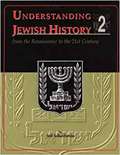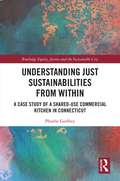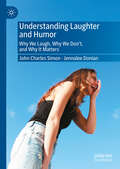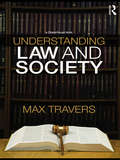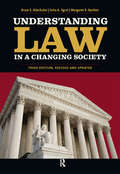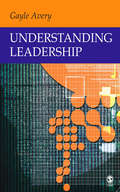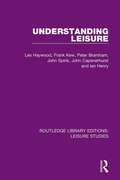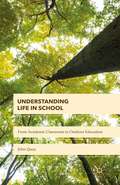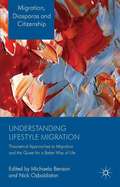- Table View
- List View
Understanding Humans: How Social Science Can Help Solve Our Problems
by David EdmondsCompiling the best episodes of SAGE′s ′Social Science Bites′ podcast since its beginning in 2012, this pocket-sized volume is sure to inspire and provoke. With a foreword by David Edmonds, host of the podcast, this book will show you how social science can help to solve problems in today′s society. It is structured into sections on identity, learning, human behaviour, social change, and the unexpected, with each chapter offering the perspective of one of the most dynamic thinkers in the social sciences. Taking a multidisciplinary approach, Edmonds′ selection of interviews includes topics such as racial inequality, moral psychology, the pandemic, and the prison system. Interviewees include Sam Friedman, Professor of Sociology at LSE, Gurminder K. Bhambra, Professor of Postcolonial and Decolonial Studies at the University of Sussex, and Jennifer Richeson, Professor of Psychology at Yale University. This book will show you the range of voices in the social sciences today, and how this diversity is what is needed to grapple with the complexity of the issues we face.
Understanding Humans: How Social Science Can Help Solve Our Problems
by David EdmondsCompiling the best episodes of SAGE′s ′Social Science Bites′ podcast since its beginning in 2012, this pocket-sized volume is sure to inspire and provoke. With a foreword by David Edmonds, host of the podcast, this book will show you how social science can help to solve problems in today′s society. It is structured into sections on identity, learning, human behaviour, social change, and the unexpected, with each chapter offering the perspective of one of the most dynamic thinkers in the social sciences. Taking a multidisciplinary approach, Edmonds′ selection of interviews includes topics such as racial inequality, moral psychology, the pandemic, and the prison system. Interviewees include Sam Friedman, Professor of Sociology at LSE, Gurminder K. Bhambra, Professor of Postcolonial and Decolonial Studies at the University of Sussex, and Jennifer Richeson, Professor of Psychology at Yale University. This book will show you the range of voices in the social sciences today, and how this diversity is what is needed to grapple with the complexity of the issues we face.
Understanding Identity and Organizations
by Hugh Willmott Kate Kenny Andrea WhittleAn understanding of identity is fundamental to a complete understanding of organizational life. While conventional management textbooks nod to in-groups, cohesion and discrimination, this text offers instead a deeper, more nuanced understanding of why people, groups and organizations behave the way they do.<P><P> With conceptions of identity perhaps less stable than they have ever been, the authors make complex theoretical issues accessible to the reader through the use of lively examples from popular culture. The authors present an overview of the key issues, as well as an examination of cutting-edge research and topical forces currently re-defining identity, such as globalisation, the fair trade movement and online identities.<P> This text is a succinct, relevant and exciting overview of the field of identity studies as it relates to business and management and applied social sciences, an is an invaluable resource to undergraduate and postgraduate students of management on any course that has an identity component.
Understanding Individual Commitment to Collective Action: Theoretical and Methodological Approaches (Routledge Studies in Political Sociology)
by Carlos RamírezWhen speaking colloquially of political participation or civic action, one thinks, in the first instance, of groups and organizations such as political parties, social movements or various types of voluntary associations. The perspective of individuals is not the first thing that comes to mind when seeking to understand their functioning. In contrast to this vision, understanding the dynamics of participation requires taking a closer look at the individual, that is, at his or her moral dispositions and projects, his or her multiple and simultaneous identities, the breaking points in his or her biographical trajectory, the roles he or she adopts in an organization or the styles of communication which he or she uses. The book comprises a variety of case studies and theoretical and methodological contributions that, independent of rational choice theories, seek to understand collective action at the level of the individual and, in doing so, to articulate the various fields of study in this regard with the singularity of biographies and the reflective personal identities that characterize contemporary individualism.
Understanding Industrial Organizations: Theoretical Perspectives in Industrial Sociology
by Richard Brown Prof Richard BrownUnderstanding Industrial Organizations critically reviews the approaches developed by industrial sociologists to analyze industrial organizations. It outlines four general perspectives on organizations - systems thinking, contingency approach, the action approach and labour process for a more adequate sociology of organizations. The book provides a clear, relevant and important contribution to the sociology of organizations.
Understanding Information History: The Case of America in 1920 (SpringerBriefs in History of Computing)
by William AsprayMicrohistory is a technique that has been used effectively by writers of both fiction and nonfiction. It enables the author to cut through the complexities of large swaths of history by focusing on a particular time and place. Microhistories are particularly useful in historical study when a subfield has recently arisen and there are not yet enough monographic studies from which to draw general patterns. This microhistory focuses on a single year (1920) across the United States, with the goal of understanding the various roles of information in this society. It gives greater emphasis to the informational aspects of traditional historical topics such as farming, government bureaucracy, the Spanish flu pandemic, and Prohibition; and it gives greater attention to information-rich topics such as libraries and museums, schools and colleges, the financial services and office machinery industries, scientific research institutions, and management consultancies.
Understanding Institutional Diversity
by Elinor OstromThe analysis of how institutions are formed, how they operate and change, and how they influence behavior in society has become a major subject of inquiry in politics, sociology, and economics. A leader in applying game theory to the understanding of institutional analysis, Elinor Ostrom provides in this book a coherent method for undertaking the analysis of diverse economic, political, and social institutions.Understanding Institutional Diversity explains the Institutional Analysis and Development (IAD) framework, which enables a scholar to choose the most relevant level of interaction for a particular question. This framework examines the arena within which interactions occur, the rules employed by participants to order relationships, the attributes of a biophysical world that structures and is structured by interactions, and the attributes of a community in which a particular arena is placed.The book explains and illustrates how to use the IAD in the context of both field and experimental studies. Concentrating primarily on the rules aspect of the IAD framework, it provides empirical evidence about the diversity of rules, the calculation process used by participants in changing rules, and the design principles that characterize robust, self-organized resource governance institutions.
Understanding Institutions: The Science and Philosophy of Living Together
by Francesco GualaUnderstanding Institutions proposes a new unified theory of social institutions that combines the best insights of philosophers and social scientists who have written on this topic. Francesco Guala presents a theory that combines the features of three influential views of institutions: as equilibria of strategic games, as regulative rules, and as constitutive rules.Guala explains key institutions like money, private property, and marriage, and develops a much-needed unification of equilibrium- and rules-based approaches. Although he uses game theory concepts, the theory is presented in a simple, clear style that is accessible to a wide audience of scholars working in different fields. Outlining and discussing various implications of the unified theory, Guala addresses venerable issues such as reflexivity, realism, Verstehen, and fallibilism in the social sciences. He also critically analyses the theory of "looping effects" and "interactive kinds" defended by Ian Hacking, and asks whether it is possible to draw a demarcation between social and natural science using the criteria of causal and ontological dependence. Focusing on current debates about the definition of marriage, Guala shows how these abstract philosophical issues have important practical and political consequences. Moving beyond specific cases to general models and principles, Understanding Institutions offers new perspectives on what institutions are, how they work, and what they can do for us.
Understanding Intellectual Disabilities: Historical Perspectives, Current Practices, and Future Directions
by Ronald L. Taylor Stephen B. Richards Michael P. BradyThe third edition provides thorough coverage of the causes and characteristics of intellectual disabilities as well as detailed discussions of the validated instructional approaches in the field today. A revised "Future Directions" chapter explores the most recent philosophical, social, legal, medical, educational, and personal issues that professionals and people with intellectual disabilities face. All chapters have been updated with recent developments in research and the newest terminology being used in the field. This comprehensive and current introductory textbook is ideally suited for introductory or methods courses related to intellectual disabilities.
Understanding Interaction: Volume 1: Evolution, Technology, Language and Culture
by Bert BongersUnderstanding Interaction explores the interaction between people and technology in the broader context of the relations between the human-made and the natural environments. It is not just about digital technologies – our computers, smartphones, the Internet – but all our technologies, such as mechanical, electrical, and electronic. Our ancestors started creating mechanical tools and shaping their environments millions of years ago, developing cultures and languages, which in turn influenced our evolution. Volume 1 looks into this deep history, starting from the tool-creating period (the longest and most influential on our physical and mental capacities) to the settlement period (agriculture, domestication, villages and cities, written language), the industrial period (science, engineering, reformation, and renaissance), and finally the communication period (mass media, digital technologies, and global networks). Volume 2 looks into humans in interaction – our physiology, anatomy, neurology, psychology, how we experience and influence the world, and how we (think we) think. From this transdisciplinary understanding, design approaches and frameworks are presented to potentially guide future developments and innovations. The aim of the book is to be a guide and inspiration for designers, artists, engineers, psychologists, media producers, social scientists, etc., and, as such, be useful for both novices and more experienced practitioners. Image Credit: Still of interactive video pattern created with a range of motion sensors in the Facets kaleidoscopic algorithm (based underwater footage of seaweed movement) by the author on 4 February 2010, for a lecture at Hyperbody at the Faculty of Architecture, TU Delft, NL.
Understanding Intercultural Communication: Negotiating a Grammar of Culture
by Adrian HollidayUnderstanding Intercultural Communication provides a practical framework to help readers to understand intercultural communication and to solve intercultural problems. Each chapter exemplifies the everyday intercultural through ethnographic narratives in which people make sense of each other in home, work and study locations. Underpinned by a grammar of culture developed by the author, this book addresses key issues in intercultural communication, including: the positive contribution of people from diverse cultural backgrounds; the politics of Self and Other which promote negative stereotyping; the basis for a de-centred approach to globalisation in which periphery cultural realities can gain voice and ownership. Written by a leading researcher in the field, the new edition of this important text has been revised to invite the reader to reflect and develop their own intercultural and research strategies, and updated to include new ideas that have emerged in Holliday’s own work and elsewhere. This book is a key resource for academics, students and practitioners in intercultural communication and related fields.
Understanding International Sign: A Sociolinguistic Study
by Lori A. WhynotIn Understanding International Sign, Lori A. Whynot examines International Sign (IS) to determine the extent to which signers from different countries comprehend it. She focuses exclusively on expository lecture IS used in conference settings and presents the first empirical research on its effectiveness for communicating rich information to diverse audience members. International Sign is regarded as a lingua franca that is employed by deaf people to communicate with other deaf people who do not share the same conventionalized local sign language. Contrary to widely-held belief, sign languages are not composed of a unified system of universal gestures—rather, they are distinctly different, and most are mutually unintelligible from one another. The phenomenon of IS has emerged through increased global interaction during recent decades, driven by a rise in the number of international conferences and events and by new technologies that allow for enhanced global communication. IS is gaining acceptance for providing communicative access to conference audience members who do not have knowledge of the designated conference languages, and it is being recruited for use due to the prohibitive expense of providing interpreting services in numerous different sign languages. However, it is not known how well audience members understand IS, and it may actually limit equal access to the interpreted information. Whynot compares IS to native sign languages and analyzes the distribution of linguistic elements in the IS lexicon and their combined effect on comprehension. Her findings indicate that audiences with diverse sign languages understand much less of IS presentations than has been previously assumed. Whynot’s research has crucial implications for expository IS usage, training, and interpreting, and it sheds light on the strengths and weaknesses inherent in cross-linguistic, signed contact settings.
Understanding International Sport Organisations: Principles, power and possibilities
by Alan Tomlinson Lincoln AllisonThe governance of international sport is dominated by the SINGOs (sporting international non-governmental organisations). The IOC, FIFA, IAAF and the FIA wield global influence, but how exactly do such complex organisations operate? This important book examines the rise of the SINGOs, their structures, organisational behaviour and their power in the context of modern sport and international politics. Written by two world-leading experts, the book sheds new light on the relationship between these SINGOs and the sports which they govern. It provides a close critical analysis of the policies and practices of the most important international sport organisations, from their historical origins to the present day. Using case studies of key events such as the Olympics and the recent FIFA scandals, it examines the central question of how best to understand the significance of these organisations today. Combining historical insight with original research, Understanding International Sport Organisations: Principles, Power and Possibilities is essential reading for anyone with an interest in the politics of sport, the sociology of sport, sport administration, sport business or sport management.
Understanding Japanese Society
by Joy HendryWith the ever growing contact between Japan and the rest of the world comes an increasingly important need to understand a society that is fascinating but still often confusing to the outsider. In this brand new fourth edition of Understanding Japanese Society Joy Hendry brings the reader up to date both with recent changes as Japan hit the world headlines under the triple 2011 disasters, and with underlying continuities in ways of thinking that have matured over a long history of dealing with foreign influences and an unpredictable environment.? This welcome new edition of Hendry’s bestselling introductory textbook provides a clear, accessible and readable introduction to Japanese society which does not require any previous knowledge of the country. Fully updated, revised and expanded, the fourth edition contains new material on: the effects of the earthquake, tsunami and nuclear disasters of 2011 a renewed interest in politics and popular participation increased frequency of local spiritual support as unemployment continues to grow, and marriage gets later and later? the effects of a dramatic drop in the birth rate on Japan’s education system the continuing global success of Japanese animation, manga and computer games despite a turn away from international travel the cool new Ainu, the attraction of healing Okinawa, and changes among other Japanese minorities a new role for Japanese fathers in child-rearing This book will be invaluable to all students studying Japan. It will also enlighten those travellers and business people wishing to gain an understanding of the Japanese people.
Understanding Japanese Society (Nissan Institute/Routledge Japanese Studies)
by Joy Hendry Emma E. CookIn this welcome new sixth edition of the bestselling textbook Understanding Japanese Society, Joy Hendry and Emma E. Cook take the reader into the heart of Japanese life.Providing a clear and accessible introduction to Japanese ways of thinking, which does not require any previous knowledge of the country, this book explores Japanese society through the worlds of home, work, play, health, religion, and ritual, covering a full range of life experiences, from childhood to old age. Fully updated, revised, and expanded with a brand new chapter on health and ageing, the sixth edition contains new material on: Experiences of the COVID-19 pandemic Changes in the family and LGBTQ experiences Increased interest in rural areas, the problems and opportunities of empty houses Use of technology and AI in different areas of life Discussion of new kinds of criminal activity and an increase in elderly offenders Each chapter in this new edition also includes an exciting insert from scholars in the field, based on new and emerging research. This book will be invaluable to all students studying Japan. It will also enlighten tourists, travellers, and business people wishing to gain an understanding of Japanese people.
Understanding Japanese Society (Nissan Institute/Routledge Japanese Studies)
by Joy HendryIn this welcome brand new fifth edition of the bestselling textbook Understanding Japanese Society, Joy Hendry takes the reader into the heart of Japanese life. Providing a clear and accessible introduction to Japanese ways of thinking, which does not require any previous knowledge of the country, this book explores Japanese society through the worlds of home, work, play, religion and ritual, covering a full range of life experiences, from childhood to old age. It also examines the diversity of people living in Japan, the effects of a growing number of new immigrants, and role of the longest-standing Japanese prime-minister Shinzo Abe. Fully updated, revised and expanded, the fifth edition contains new material on: the continued effects of the earthquake, tsunami and nuclear disasters of 2011 local examples of care for nature and the environment new perspectives on the role of women Japan’s place in the context of globalization . Each chapter in this new edition also includes an exciting insert from scholars in the field, based on new and emerging research. This book will be invaluable to all students studying Japan. It will also enlighten those travellers and business people wishing to gain an understanding of the Japanese people.
Understanding Jewish History
by Sol ScharfsteinRecords the many stories of the journey of the Jewish people through history.
Understanding Just Sustainabilities from Within: A Case Study of a Shared-Use Commercial Kitchen in Connecticut (Routledge Equity, Justice and the Sustainable City series)
by Phoebe GodfreyWritten by the co-founder and former board president of a non-profit shared-use commercial kitchen, Understanding Just Sustainabilities from Within presents an intersectional analysis of CLiCK (Commercially Licensed Co-operative Kitchen), in order to explore what just sustainabilities can look and feel like from within and without. Through a unique combination of auto ethnography, participant observation, surveys and secondary research, this book offers insights into CLiCK’s micro and macro successes, failures, and unknowns in relation to its attempt to put the concept of just sustainabilities into daily practice, and praxis. Developing its practical analyses from a theoretical basis, this book does not focus on definitive answers, recognizing instead that the closest we can get to understanding just sustainabilities in praxis is through long-term collective struggle and ultimately love. Researchers and educators who are interested in linking theory with practice, especially in relation to just Sustainabilities and intersectionality, will appreciate the theoretical grounding, making it desirable for multiple social science classes. Additionally, those involved with the social justice, food justice and just sustainabilities movements will benefit from the book’s insights into best practices to address issues of social inequalities on the micro level, while also offering the benefits of a macro intersectional analysis.
Understanding Laughter and Humor: Why We Laugh, Why We Don’t, and Why It Matters
by Jennalee Donian John Charles SimonThis book puts forward a revolutionary and comprehensive theoretical approach to understanding laughter and the humor we use to inspire it. This new perspective applies an evolutionary and biological lens through which we can fully appreciate these complex, universal human behaviors. It distinguishes itself from all classical and contemporary theories by revealing laughter&’s singular message, rather than simply its causes and effects, and makes clear why perceptions of vulnerability and status are ever-present in our conscious and subconscious thoughts. The theory underscores our innate desire to cooperate, our respect for those who compete fairly, and our disdain for those who do not. And it sheds light on the social dynamics governing human interactions, both positive and negative, by recognizing laughter not as a reflexive reaction to a certain class of stimuli, but as a vital form of nonverbal communication—not only for us, but for our great ape cousins as well.
Understanding Law and Society
by Max TraversThis textbook on the sociology of law is organised according to the theoretical traditions of sociology, and oriented towards providing an accessible, but sophisticated, introduction to, and overview of, the central themes, problems and debates in this field. The book employs an international range of examples - including the state, minority rights, terrorism, family violence, the legal profession, pornography, mediation, religious tolerance, and euthanasia - in order to distinguish a sociological approach to law from 'black-letter', jurisprudential and empirical policy-oriented traditions. Beginning with 'classical', 'consensus' and 'critical' sociological approaches, the book covers the full range of contemporary perspectives, including the new institutionalism, feminism, the interpretive tradition, postmodernism, legal pluralism and globalisation. It then concludes with a consideration of current theoretical issues, as well as a reflection upon the importance of a sociological approach to law. Understanding Law and Society provides a clear, but critical, discussion of the relevant literature, along with study questions and guides to further reading. It is designed to support courses in law and society and in the sociology of law, but will also be of value to others with interests in these areas.
Understanding Law in a Changing Society
by Bruce E. Altschuler Celia A. Sgroi Margaret R. RynikerTo most Americans, the law-especially noncriminal law-is a mystery that only someone with a law degree can solve. Understanding Law in a Changing Society renders the complexity of law at a level that everyone can understand. The book walks readers through the structure of the legal system, different divisions of civil law, and the core concepts and distinctions that underlie contemporary legal thought. It also provides insight into the way law and social change affect one another. With this revised and updated third edition, the authors have incorporated an updated preface and a new introduction; outlined a "How to Brief a Case" section; included new case studies, readings, and "You be the Judge" features for selected chapters; and for the first time added a glossary of legal terms and key websites to the book. Important developments in judicial selection, the state secrets doctrine, and family law (including same sex marriage, child custody, and unwed fathers' rights) are highlighted.
Understanding Leadership: Paradigms and Cases
by Gayle C AveryAre current concepts of leadership appropriate for today's organizations? What will tomorrow's leadership need to be like? Is there a best approach to leadership? With a huge range of definitions and theories of leadership available, the field has become confusing for both students and practitioners alike. This text provides a framework for making sense of the field. In Part One, Gayle C Avery integrates a fragmented field into four broad paradigms or forms of leadership, helping to simplify and clarify the ill-defined field of leadership. The second part provides 10 case studies from leading organizations across Europe, Australia and the United States to illustrate how diverse leadership can be in successful organizations. At the end of each case, specific questions guide the reader in interpreting and analyzing the cases, connecting them to the leadership frameworks and theories in Part One. Written in simple language, Understanding Leadership can be used by readers with no prior knowledge of leadership. With its overview of major theories in the field and presentation of a simple and effective framework for analyzing these theories, the book will be essential reading for advanced undergraduate and MBA students. Avery has devised a set of powerpoint slides to accompany the book and support lecturers. They are available to view under Sample Materials and Chapters or under Links and Resources
Understanding Leisure (Routledge Library Editions: Leisure Studies)
by Peter Bramham John Spink Ian Henry Frank Kew Les Haywood John CapenerhurstFirst published in 1989. Understanding Leisure is a readable introductory analysis of the key elements in the study of leisure. This includes leisure concepts and dimensions of leisure, its activity forms, participants, provision, and leisure futures, leisure and social theory. A collaborative work of six authors, Understanding Leisure is a textbook which introduces the reader to the interrelated dimensions of leisure in contemporary society and aims to provide them with guidelines for further study. Exercises and discussion topics are included at the end of each chapter to enable the reader to apply general theory to particular examples. The text contains seven chapters covering all aspects of the study of leisure. Starting with a critical evaluation of different concepts of leisure it progresses through an analysis of the relationship between leisure both to play and work and the diverse forms of leisure such as recreation, hobbies, crafts and education. There then follows a perspective on leisure participation, an analysis of the spatial dimensions of leisure and how relative land values can affect access to leisure. The historical context of leisure provision and the changing relationship between public and private sector is then examined which provides insights into the future of leisure, based on forecasts and theories of social change. The book ends with a discussion of how contemporary social theory contributes to an understanding of leisure. Understanding Leisure will be valuable reading for undergraduate degree courses in Leisure Studies. It will also be useful background reading for post graduate study in Leisure and Recreational Management and Tourism as well as for leisure professionals in both the commercial and public sectors.
Understanding Life in School: From Academic Classroom to Outdoor Education
by John QuayAttending school is an experience that most people share but this leads us to accept rather than question the experience. Using the philosophies of Heidegger and Dewey, John Quay explores life in schools and juxtaposes the environment of a school camp with that of an academic classroom.
Understanding Lifestyle Migration
by Nick Osbaldiston Michaela BensonThis book draws on social theories to understand lifestyle migration as a social phenomenon. The chapters engage theoretically with themes and debates relevant to contemporary social science such as place and space, social stratification and power relations, production and consumption, individualism, dwelling and imagination.
